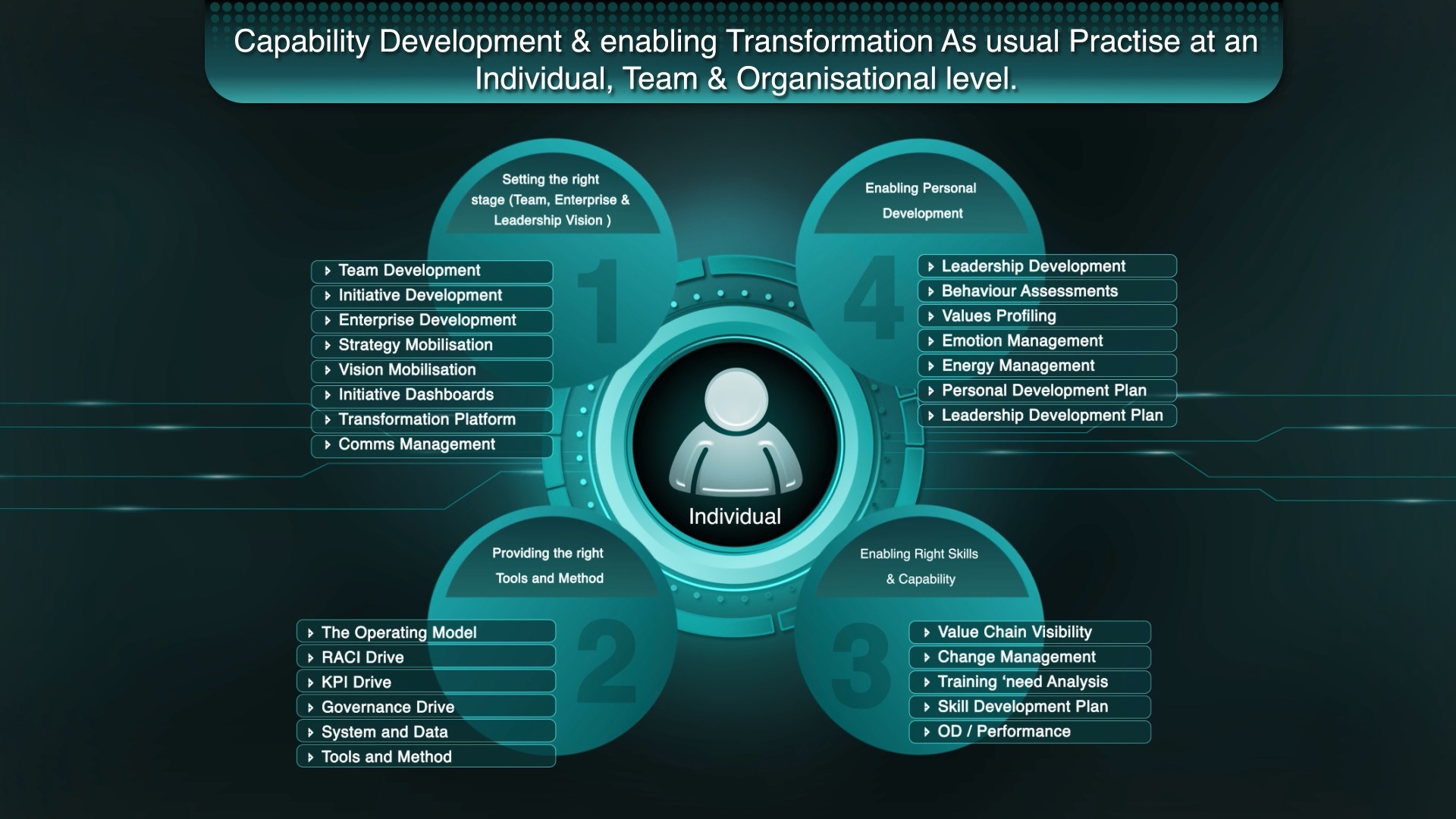Banking Services – Enterprise Business Transformation
An Introduction To Our Banking Services Platform
Modus Business Transformation Core Modules
Building, Driving and Sustaining your Business Transformation and embedding a 'Transformation As Usual' platform.
01 - Business Model Management - Manage and Adapt
Embrace the Business Model Management Hub to navigate and thrive in the ever-evolving business landscape with confidence and clarity.
Key Features:
• Value Chain Modeling: A crucial tool for analyzing and managing financial
processes, identifying dependencies, and aligning business objectives with
operations across departments.
• Transformation Strategy Setup: It focuses on aligning strategic goals with
execution frameworks, ensuring the bank’s operating models reflect the
desired business outcomes.
• Financial Dashboards and Forecasting: Continuous tracking of financial
performance, risks, and KPIs to provide real-time insights into profitability,
budgeting, and asset management.
Importance:
• Operational Efficiency: By managing business models effectively, banks
streamline their operations, making workflows more efficient and reducing
costs.
• Strategic Alignment: It ensures that the bank’s business models are closely
aligned with strategic goals, fostering agility in responding to market c
changes and competitive pressures.
• Regulatory Compliance: Business model management supports adherence
to financial regulations, enhancing transparency and mitigating risks
associated with non-compliance.
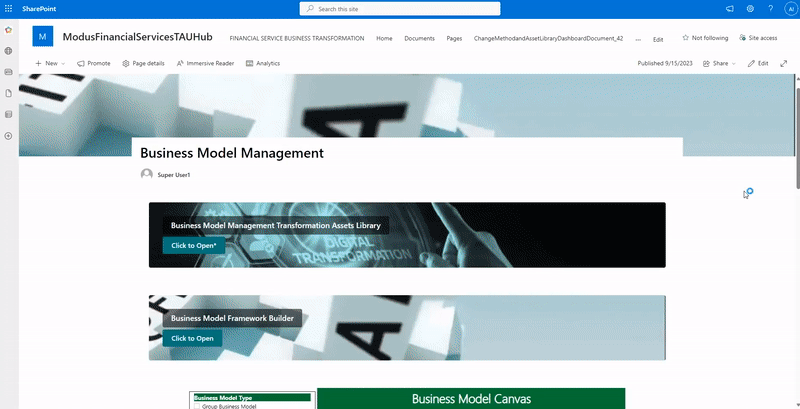
Benefits:
• Improved Decision-Making: Through comprehensive data and financial
performance tracking, banks gain deeper insights, enabling faster and more
informed decisions.
• Enhanced Customer Experience: By leveraging value chain modeling and
business transformation, banks can better tailor services to customer needs,
increasing satisfaction and loyalty.
• Agility and Innovation: Effective business model management encourages
continuous improvement and innovation, allowing financial institutions to
adapt swiftly to technological advancements and market dynamics.
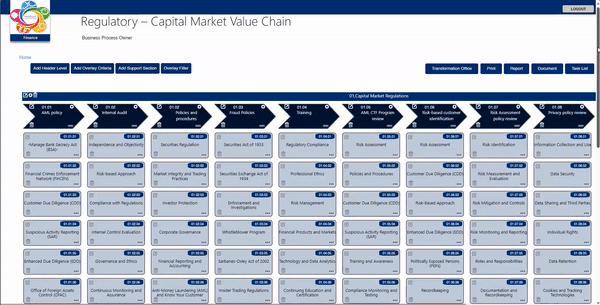
Benefits:
• Operational Efficiency: By identifying bottlenecks and inefficiencies, the
Value Chain Modeler helps banks optimize workflows and reduce costs.
• Regulatory Compliance: The ability to track financial data and processes
ensures that banks can meet regulatory requirements more easily, reducing
the risk of non-compliance penalties.
• Informed Decision-Making: The real-time data integration and forecasting
capabilities enable banking leaders to make data-driven decisions,
improving both day-to-day operations and long-term strategic planning.
02 - The Value Chain Modeler - Manage and Adapt
Harness the power of the Value Chain Modeler to drive your business forward with clarity, precision, and confidence.
Key Features:
• End-to-End Financial Process Mapping: The Value Chain Modeler offers a
detailed mapping of all financial processes, from customer acquisition to
product delivery, allowing for precise identification of interdependencies
across departments (e.g., loans, investment, risk management).
• Integration with Business Models: It links the value chain to the broader
business model, aligning financial services, operational workflows, and
customer interactions with the bank’s strategic goals.
• Real-Time Data Integration: Incorporates financial data from various sources
(e.g., treasury, risk, accounting) to monitor key metrics, providing a
comprehensive view of the bank’s operational efficiency and financial health.
Importance:
• Alignment of Strategy with Operations: The Value Chain Modeler ensures
that banking operations are tightly aligned with strategic objectives, fostering
agility in decision-making and responsiveness to market changes.
• Improved Risk Management: By visualizing the end-to-end processes,
banks can better identify risks and inefficiencies, ensuring more effective
management of both financial and operational risks.
03 - The Operating Model - Organize and Sustain
Utilize the Operating Model to keep your business operations organized, efficient, and adaptable, ensuring long-term success and growth.
Key Features:
• Target Operating Model (TOM): Defines the future state of the bank’s
operations, linking strategic goals with organizational functions. This includes
processes, systems, roles, data, and KPIs.
• End-to-End Process Management: The operating model captures and
integrates all financial processes, from customer-facing services (e.g.,
account management, loan origination) to back-office operations (e.g., risk
management, compliance).
• System and Data Integration: Incorporates IT systems, data flows, and
financial tools, ensuring smooth coordination across platforms (e.g., CRM,
ERP, compliance systems) to maintain operational consistency.
Importance:
• Alignment with Strategic Goals: The operating model ensures that all
banking functions and processes are aligned with the overall strategy,
enabling efficient execution of strategic objectives.
• Improved Regulatory Compliance: By integrating regulatory requirements
into the operating model, banks can better manage compliance, reducing the
risk of penalties and enhancing trust with regulators.
• Risk Management: Ensures that risks related to operations, financial
performance, and customer interactions are managed through a
comprehensive view of processes and systems.
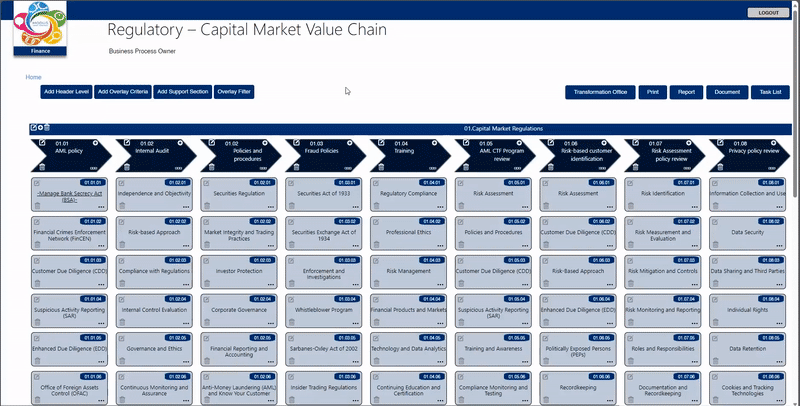
Benefits:
• Operational Efficiency: The model helps banks streamline their processes,
eliminate inefficiencies, and reduce costs through better resource
management and process automation.
• Enhanced Agility: With the ability to adapt the operating model to changing
market conditions or regulatory demands, banks can remain competitive and
responsive to external challenges.
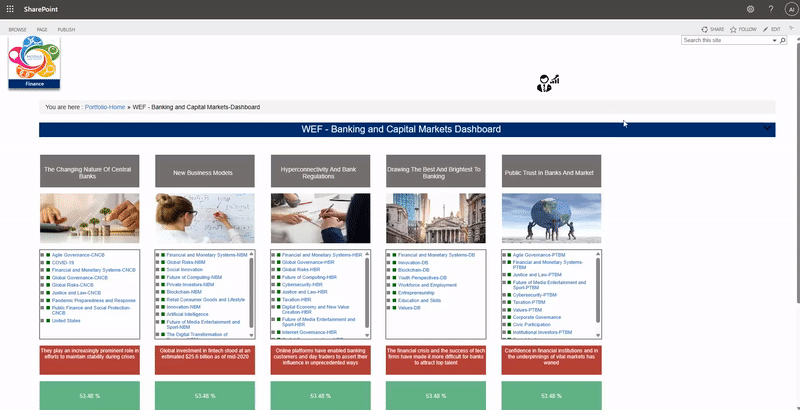
Benefits:
• Enhanced Efficiency and Productivity: Automation of project management
tasks, such as reporting, planning, and resource allocation, reduces manual
effort and improves the efficiency of transformation initiatives.
• Increased Agility in Transformation: By offering a flexible framework for
project management, the module.
04 - The Transformation Assets and Portfolio Module - Discover and Transform
Leverage the Transformation Assets and Portfolio Module to drive successful and sustainable business transformations with clarity and efficiency.
Key Features:
• Centralized Asset Bank: This module provides access to a comprehensive
repository of over 400 transformation assets, including methodologies, tools,
templates, and frameworks tailored to banking operations (e.g., compliance,
risk management, customer service).
• Integrated Portfolio Management: Manages a suite of projects within the
transformation portfolio, ensuring each initiative is aligned with strategic
goals. It offers centralized visibility and control over various transformation
efforts (e.g., digital transformation, regulatory changes).
Importance:
• Alignment with Strategic Transformation: The module ensures that all
transformation activities, whether operational or digital, are aligned with the
bank’s broader strategic objectives, such as growth, compliance, and
customer satisfaction.
• Improved Governance and Oversight: With centralized project oversight, the
module ensures that projects are executed with greater accountability,
reducing the risk of delays or failures due to mismanagement or
misalignment.
• Value Chain Analysis
• Business Model Analysis
• Transformation Strategy
• Transformation Mobilisation
• Planning Management
• Transformation Log Management
• Financial Management
• Communication Management
• Operating Model Management
• Process Design Management
• IT Design Management
• Build and Test Management
• Implementation Management
• Change Management
• Personal Development Assessments
• Training Management
• Organizational Design Management
• Transformation Review
• Optimization and Governance
05 - Organizational Change Management - Unite and Thrive
Utilize the Organizational Change Management module to unite your team and thrive through effective, sustainable change.
Key Features:
• Structured Change Methodology: The OCM module provides a
comprehensive framework for managing change across the entire bank,
from strategic alignment to execution. It includes predefined tools, templates,
and methods for consistent change management.
• Stakeholder Engagement Tools: Tools for identifying, engaging, and
managing stakeholders, ensuring all key parties (e.g., employees,
customers, regulators) are informed and aligned throughout the change
process.
• Role-Specific Training and Adoption Plans: Customized training and role-
specific adoption plans to ensure that employees across the organization
understand and embrace the changes being implemented.
Importance:
• Alignment of Change with Business Goals: Ensures that organizational
changes are aligned with the bank’s strategic goals, whether they involve
new regulations, digital transformation, or operational improvements.
• Minimization of Disruption: By carefully managing change processes and
engaging all relevant stakeholders, the OCM module helps to minimize
operational disruptions, ensuring that critical banking services continue
without interruption.
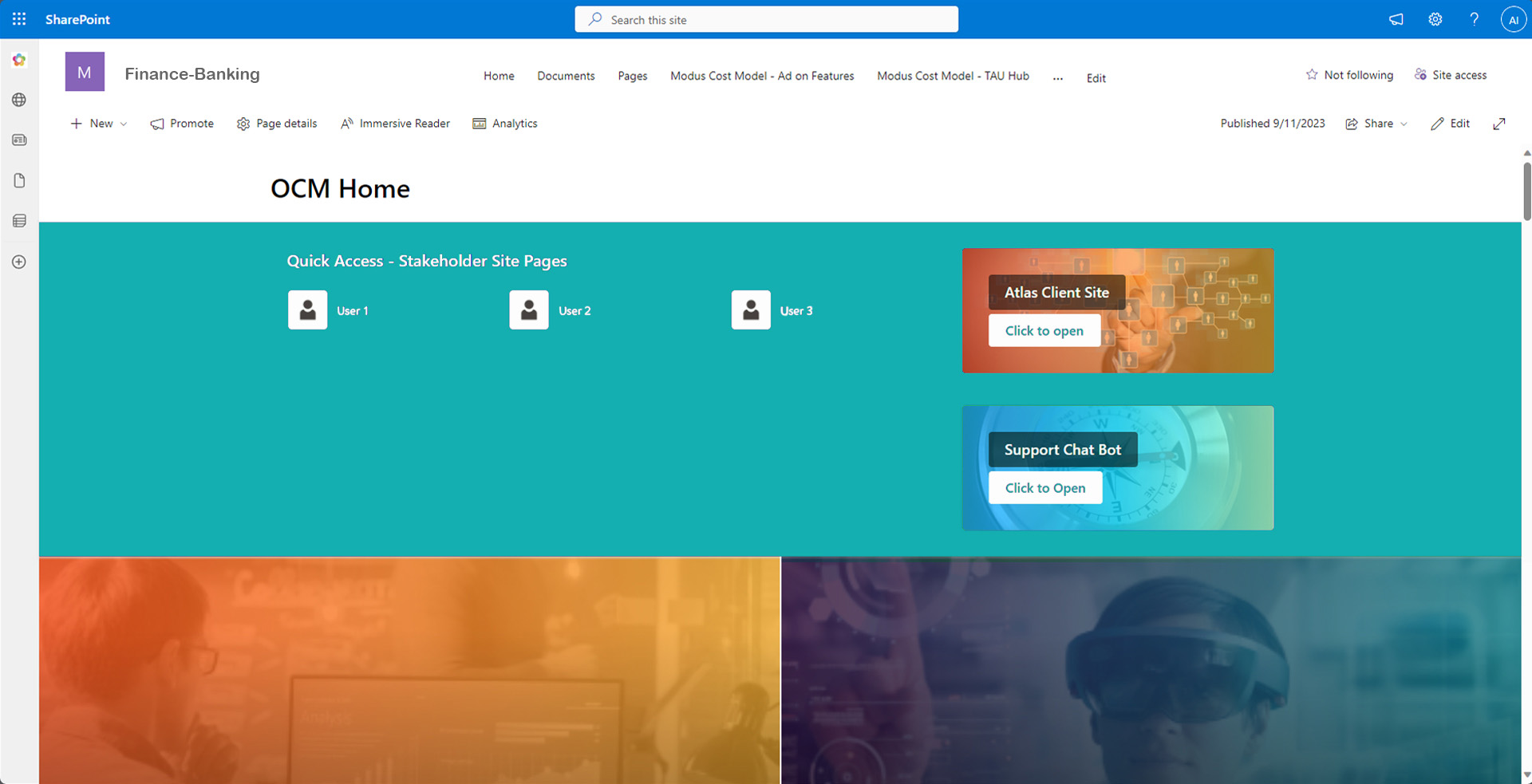
Benefits:
• Faster Adoption of Changes: With role-specific training and clear
communication plans, the OCM module accelerates the adoption of new
processes, systems, and regulatory requirements across the organization.
• Improved Employee Engagement: The structured change management
approach fosters greater engagement and reduces resistance among
employees, making it easier for them to adapt to new roles, responsibilities,
or technologies.
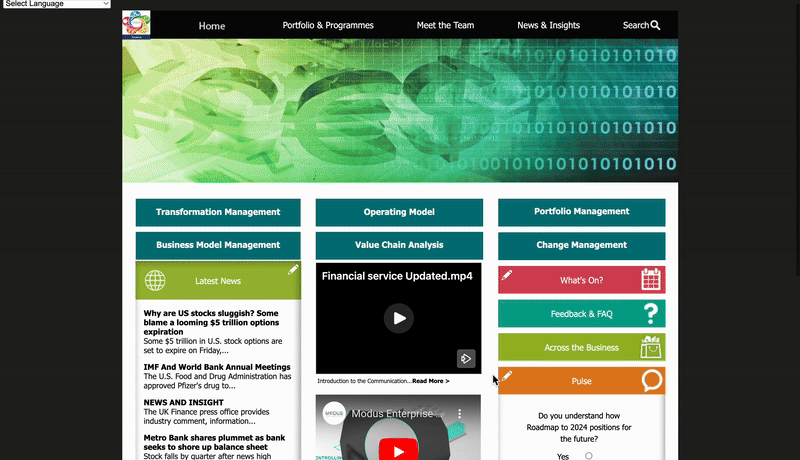
Benefits:
• Increased Productivity: By centralizing access to all relevant information and
providing tools for collaboration, the hub boosts productivity, allowing teams
to focus on execution rather than chasing updates or approvals.
• Faster Decision-Making: With real-time access to transformation progress
and key project data, banking leaders can make faster, more informed
decisions, driving smoother execution of changes.
• Improved Stakeholder Engagement: The hub allows better management of
stakeholder relationships by providing timely updates and ensuring that all
concerns or feedback are addressed promptly, leading to higher levels of
engagement and satisfaction.
06 - Engagement Hub - Share and Guide
Utilize the Engagement Hub to streamline your communication, enhance team collaboration, and guide your organization through successful transformations.
Key Features:
• Centralized Communication Platform: The Engagement Hub provides a
single interface for all communication related to banking transformation
projects, offering access to reports, updates, and project progress in real-
time.
• User-Specific Dashboards: Tailored dashboards for different roles (e.g.,
executives, project managers, team members), providing relevant and up-to-
date information to each user based on their responsibilities within the
transformation process.
• Collaboration Tools: Enables cross-team and cross-department
collaboration, ensuring that banking professionals can work together
seamlessly on shared goals, whether they’re located in different regions or
departments.
Importance:
• Transparency: Provides all stakeholders (employees, customers, regulators)
clear visibility into the transformation, building trust.
• Efficient Communication: Centralizes updates to avoid silos and ensure
consistent information across teams.
• Enhanced Collaboration: Facilitates cross-functional coordination between
key areas like IT, risk, and compliance, essential for transformation success.
Transformation As Usual Capability Model
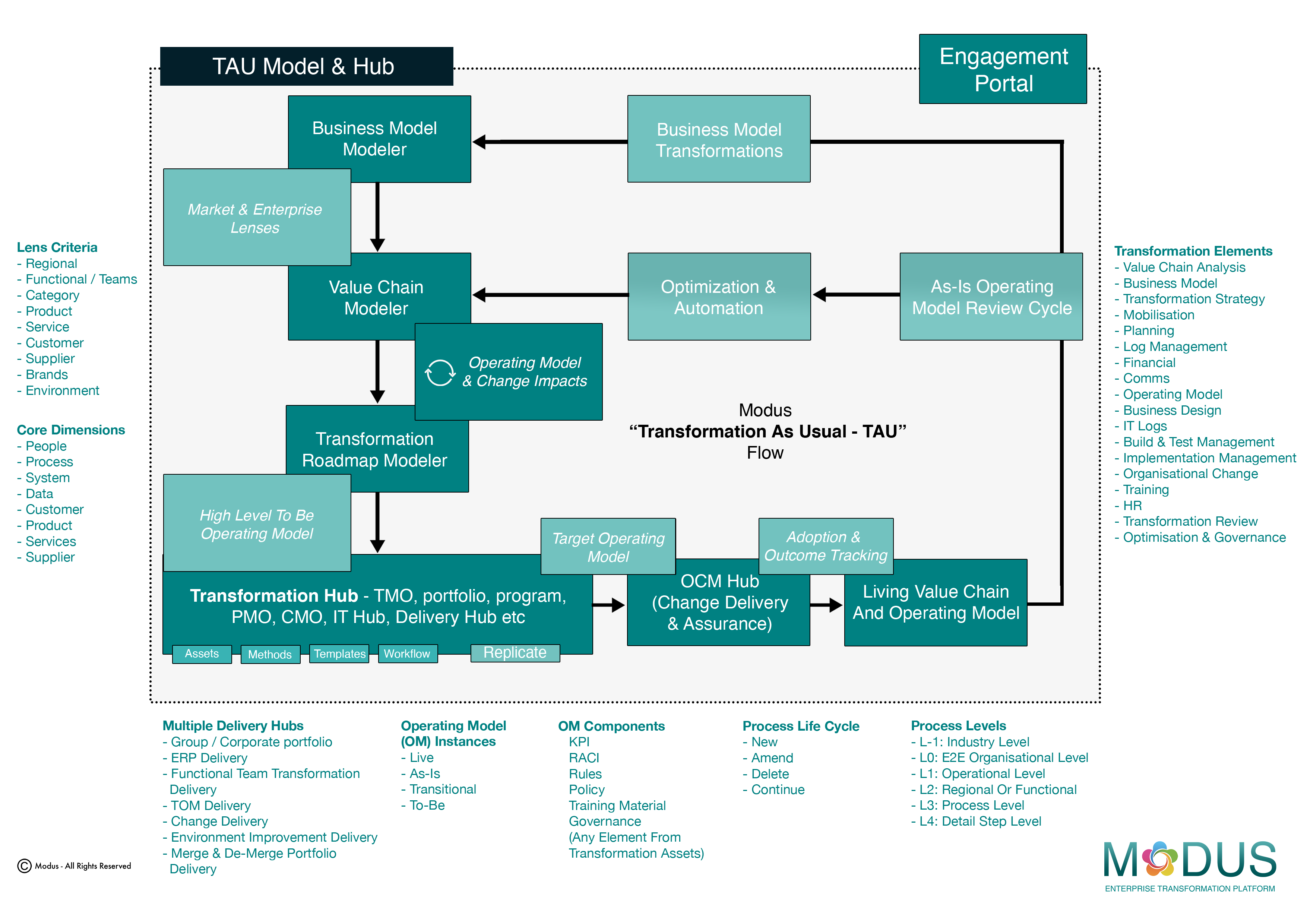
Individual and Team Capability Development
